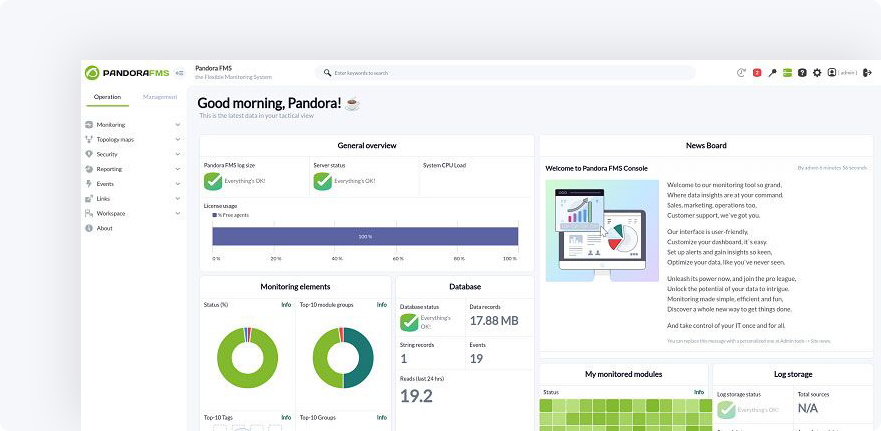Oracle データベースの監視
Discovery Server から Pandora FMS で Oracle を簡単にコントロール
直感的なウェブインタフェースから多くのメトリクスを監視できます。 vSphere 環境に何もインストールすることなく、Oracle データベースからリモートでメトリクスを取得できます。
包括的かつ効率的な監督

包括的モニタリング
任意のOracleデータベースにリモート接続して詳細なパフォーマンス・メトリクスを取得し、応答時間を測定して最適なパフォーマンスを確保できます。

リアルタイム表示
Oracleデータベースの状態を常に把握し、迅速かつ効果的な意思決定を行うことができます。

カスタムレポート作成
詳細な分析と情報に基づいた意思決定のために、さまざまなデータベースからグラフとパフォーマンスレポートを組み合わせて作成します。

インスタント・アラート
電子メール、SMS、Telegram、その他のチャットツールを通じて、簡潔かつ即時のアラートを受信し、異常が発生したことをお知らせします。

マルチデータベース管理
さまざまなデータベースを、その重要度に応じたカスタムメトリクスとインターバルで管理し、大規模なインフラの管理を容易にします。

セグメント化された可視性
より効率的でカスタマイズされた管理のために、異なるグループや顧客にセグメント化された可視性を提供します。

カスタム・クイック・セットアップ
Pandora FMS から Oracle DB の監視タスクを設定するのはとても簡単です。
1. オラクル・アプリケーションを選択
Oracleアプリを選択してウィザードを起動します。
2. 必要なパラメータを追加する
データベース接続文字列やユーザー認証情報など、必要なパラメータを入力します。カンマ区切りで複数の接続文字列を追加することができ、同じ構成と認証情報で複数のデータベースを監視できます。
3. メトリクスを選択する
ユーザー・インターフェースから、いくつかの定義済みメトリクスのオプションから簡単に選択し、監視したり、このタスクのためのカスタム・クエリーを定義したりすることができます。
4. ディスカバリー・タスク・リストを参照
ウィザードの最後には、スケジュールされたすべてのディスカバリー・タスクのリストと各タスクのステータスが表示されます。
5. 実施概要
さらに、簡単な方法で実行の概要を詳しく見ることができる。

明確で正確な結果
このタスクを実行すると、モニタリング・セクションで有効になっているメトリクス、またはカスタム・メトリクスが定義されているかどうかによって、異なる結果が返されます。
指標
If engine_uptime is enabled
| restart_detection | It will be 0 if an unexpected restart was detected, and 1 if this is not the case. When a server restarts unexpectedly, there can be an interruption in access to the database and transactions or data that are not properly saved may be potentially lost. |
If query_stats is enabled
| queries: select | Number of SELECT queries. SELECT queries are used to retrieve data from the database. Monitoring SELECT queries allows you to evaluate query efficiency and index optimization. By identifying slow or inefficient SELECT queries, you may take steps to improve their performance, such as adding appropriate indexes, optimizing queries, or adjusting server configuration. |
| queriers: update | Number of UPDATE queries. UPDATE queries are used to modify existing data in the database. Monitoring UPDATE queries is important to assess the frequency and efficiency of data updates. You may identify UPDATE queries that affect a large number of rows or have a significant impact on server performance. This allows you to optimize queries, double check table structure or take steps to reduce the load generated by updates. |
| queries: delete | Number of DELETE queries. DELETE queries are used to retrieve data from the database. Monitoring DELETE queries is useful for assessing the frequency and efficiency of data deletions. You may identify DELETE queries that affect a large number of rows or have a significant impact on server performance. This allows you to optimize queries, double check table structure or take steps to reduce the load generated by deletions. |
| queries: insert | Number of INSERT queries. INSERT queries are used to enter new data into the database. Monitoring INSERT queries allows you to assess the frequency and efficiency of data insertions. You may identify INSERT queries that generate a high load on the server or that could be causing performance issues. This allows you to optimize queries, double check table structure, or consider delayed insertion strategies to improve performance in high-concurrency environments. |
If analyze_connections is enabled
| session usage | Number of current connections regarding the total maximum connections. Monitoring session usage in SQL Server is important for optimizing performance, identifying blocking issues, improving security and auditing, and efficiently planning server resources. |
If cache_stats is enabled
| cache hit ratio (dictionary) | The dictionary cache ratio. The “Cache Hit Ratio (Dictionary)” refers to the proportion of Oracle dictionary data access requests solved using cached data compared to requests that require disk access. The Oracle Dictionary contains information about the database structure, items, metadata, and other important details. A high hit ratio indicates that most dictionary access requests are solved using cached data, which improves system performance by preventing disk access. |
| cache hit ratio (library) | The library cache ratio. The “Cache Hit Ratio (Library)” refers to the proportion of access requests to Oracle procedures, functions, and packages stored in the shared library cache. The shared library cache stores the compiled code of frequently executed SQL programs and queries. A high hit rate indicates that most requests are solved using cached code, which avoids the need to recompile and improves performance by reducing runtime. |
| cache hit ratio (buffer) | The buffer cache ratio. The “Cache Hit Ratio (Buffer)” refers to the proportion of Oracle dictionary data access requests solved using cached data compared to requests that require disk access. The buffer cache stores the data blocks that are read or modified frequently. A high hit rate indicates that most data access requests are solved using blocks stored in the buffer cache, reducing the need to access the disk and improving overall system performance. |
If check_tablespaces is enabled
| tablespace |
Use percentage in GB. It is important to monitor the “tablespace free” in Oracle to keep track of the amount of space available in the tablespaces. This allows you to proactively manage the growth of storage space and avoid insufficient space issues that may affect database functionality. When monitoring free tablespace, actions such as adding more storage space or making adjustments to settings can be taken to ensure that enough space is available. |
| tablespace |
Table status, 1 if online and 0 if not. Monitoring tablespace status in Oracle is critical to assessing the health and condition of tablespaces. It provides information on the structural integrity of tablespaces, including the existence of errors or corruption issues. By monitoring the tablespace status, you may detect problems early and take steps to fix them, such as restoring from backups or performing recovery tasks. This ensures database continuity and stability, preventing data loss or performance deterioration due to tablespaces issues. |
If fragmentation_ratio is enabled
| fragmentation ratio | The fragmentation ratio. The Fragmentation Ratio in Oracle Database is a value that indicates the amount of space wasted due to fragmentation in a data structure. A high Fragmentation Ratio indicates greater fragmentation and a greater waste of space, which may affect system performance. |
プラグインはまた、設定ファイルで定義されたカスタムクエリごとにモジュールを作成します。
Pandora FMS による Oracle リモート環境モニタリングの設定と最適化
Pandora FMS は、Oracle の統合とモニタリングを容易にするだけでなく、ネットワークインフラ全体を管理する先進的なツールを提供します。この強力な組み合わせにより、最適なパフォーマンスと効率的なデバイス管理を実現します。














